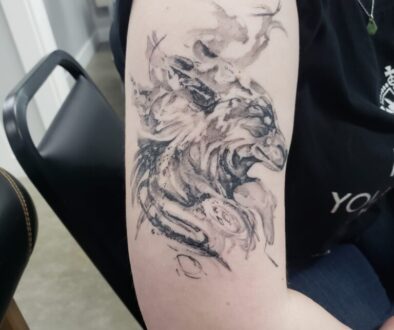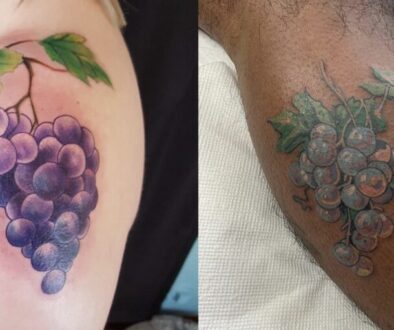The Science Behind White Ink And Tattooing: Does It Last?
|
Listen to this Article::
|
Tattooing as a form of self-expression has taken off in the past decade. As a result, new tattoo styles have begun to emerge.
Enter white ink tattoos (also known as white pigment tattoos).
While this style of tattooing has its detractors, the issue of how best to use white pigment is of more importance to those doing the tattoo. Since the worry of using the pigment correctly falls on those with the skill to implant it in others’ skin, clients are hoping for a return on their investment by having that bright white tattoo adorning their body look good for years to come.

Table of Contents
What’s Up with White Tattoo Ink?
White ink is made from nano-dispersed titanium dioxide (TiO2), zinc oxide, or a combination of both. These products are found in everyday life. From food to paint, from tattoo pigment to electronics, white coloring is ubiquitous in our modern world. Here is a short video talking about white pigment and how it works. It goes over some things that may be helpful to know before you read the article below.
What Makes White Tattoo Pigment Unique?
White ink is added to nearly every tattoo pigment in today’s market. This is because it acts kind of like a color supercharger. Titanium dioxide’s structure reacts with light, making the pigment particles mixed with look brighter. It does this by refracting light onto pigment particles next to it. Zinc oxide, on the other hand, helps dilute the vividness of colors.,
Like shining a flashlight in a dark room, TiO2 makes things more colorful. At the same time, zinc Oxide makes things appear softer.

Because it is so easy to produce and readily available, white inks have been added to almost all commercially available tattooing pigments.
The Physics of White Ink.
This “brightening effect” relates to the energy position of electrons in the materials that are being affected. Higher energy photons (Light energy) excite electrons in certain valence shells outside the nucleus of this compound. AS it interacts with the white ink, the photon’s energy is passed on and excites electrons in the TiO2, moving it further away from the center of the atom. This transmittance of energy amplifies viewable white color, but only when the color next to it is similar to its output.
For example, if you had a blue pigment mixed with a TiO2-based white ink that transmitted blue light effectively, the blue color would look more vibrant. This is because the white’s energy output was similar to the pigment next to it. If that same white ink were put next to a red pigment, the effect would not be as dramatic.
At the same time, if a zinc-oxide-based white pigment were added to that same blue, a lighter blue would be made.
Does The Pigment Flake Size Make a Difference?
Depending on the diameter of pigment used, the color of light that is refracted/reflected changes.
Wavelengths interacting with TiO2 become more focused: Reds become redder; blues become bluer. The color of light produced can be changed by modifying the size of the pigment flake. The longer raw white pigment powder is ground, the finer it becomes. The more refined it becomes, the more significant effect it has on the pigment it is added to.
Zinc oxide doesn’t act the same way. It reflects all light energy imparted on it and appears white-ish to those looking at it. Have you ever wondered why some white ink tattoos look grey or even brown? This is because zinc oxide pigments don’t look white like those made with TiO2. They are more of an off-white color, regardless of the particle size.
Because it is so easy to manipulate white ink, pigment producers can customize the effectiveness of colors by simply making the size of TiO2 particles bigger or smaller. This is why companies make premixed pigments. They can control what sized particles go into each color produced. They know that mixing colors, even if they come from the same brand, can decrease how vibrant the color shows.

White Inks Tend to Pull Away from Other Colors.
Due to white inks’ structure and polarity, the longer it sits in the skin, the more likely it will attract itself away from the colors it is mixed with.
All tattoo pigments put in the skin are held in place by the body’s immune system and skin cells. This immune function constantly renews itself to keep the ink held fast by remodeling itself as time passes. As new skin cells are made, others are pushed out or absorbed. When this happens, the body cannot push the white ink out of the skin. Instead, pigments slowly fall deeper into the skin until they are absorbed into the lymphatic system.
There may be a connection between the transport of colors to the lymph nodes and the particle size of TiO2, but there is a lack of research to back that up.
During a tattoo, white ink can change color when:
- Residual ink is left in the tube or on the tattoo machine’s needle. If white ink is going to be added to a tattoo at the end of the tattoo, it will likely mix with small residual colors left in the tube tip. Regardless of how well the artist cleans the needle/tube, the leftovers will tint the white.
- Pigment that hasn’t been washed off the skin mixes with the pigment in the tube, tinting the white ink.
- During the healing process, tattoo inks in the skin move a bit. This movement of inks can cause neighboring colors to blend. We assume the older a tattoo becomes, the more this happens.
- White inks tend to aggregate, which changes how they brighten other colors when in the skin.
- The skin’s natural pigmentation may dye TiO2, slowly causing the white color to become more like the wearer’s natural skin tone. At the same time, zinc oxide doesn’t look white once in a person’s skin.
Why Does That Mean for Your Color Tattoo?
When white tattoo ink aggregates (clumps together), it changes how it works.
The ability to refract light is diminished or altogether stopped. The relatively transparent pigment particles become opaque, and the tattoo loses that vibrancy it once had. Usually, this isn’t a big deal, but the effect is noticeable if the white ink is part of a larger tattoo. Colors start to fade more rapidly, the brightness of the colors tends to wane, and the depth needed to create a striking design is lost. This is why seeing a fresh tattoo can be so striking while a 10-year-old tattoo looks faded.

What About White-Ink-Only Tattoos?
White tattoos may look amazing when they are fresh; the image will change as the tattoo ages.
First, all pigment put into the skin is placed BELOW your skin’s natural pigmentation. Natural skin tones will sit on top of the pigment as the tattoo heals and the damaged epidermis is replaced. This means you will see the tattoo through that filter of your skin’s color. Your white ink tattoo will permanently be tinted unless you have no natural skin pigmentation.
Secondly, as the body slowly absorbs the smaller particles of white ink, the tattoo will begin to disappear.
Why Is My Tattoo Bumpy or Raised?
This occurs for a few different reasons:
-
Significant Trauma Occurred, Which Scarred the Client’s Skin.
When a tattoo is being done with most colors, the insertion of a pigment is easily seen, given the skin tone being worked on. With light colors in some skin tones, the ability of the pigment to shine through the skin’s natural colors is limited. Because it has been limited, artists may choose to go over the area being tattooed multiple times or until they see the color being worked with shine through.

Most people skilled with tattooing darker-toned skin know that committing ink to skin takes different techniques compared to lighter complexions. When running a line or filling in a section with color, the effect of the tattoo may not be seen for a few seconds. The skin reacts to being traumatized and swells bleeds, and oozes, which can block the viewer’s eye from seeing how effective their technique was. I often see artists going back in without waiting, wanting to get that dopamine hit from running a perfect line in a single shot. That ideal line may already be in the skin, but the tattoo artist’s not waiting for it increases the chances of running into increased trauma during the procedure.
-
The Aggregations of Pigment Raise the Skin.
As tattoos heal, the pigment settles into the skin. This settling is accelerated during the first 2-6 months of the tattoo healing as the skin is remodeled after being traumatized during the procedure. The skin also changes because a foreign substance has been implanted into it.
White pigment is very dense, and when inserted into the skin, it can cause a raised effect, especially when densely saturated. The raised effect due to heavy saturation can decrease or vanish over time – as long as the skin isn’t scarred.

-
Single Pass White Ink Tattoo Won’t Give the Best Results.
When a white ink tattoo is done, a tattoo artist is forced to focus on having an even saturation of color implanted into a client’s skin. With most colors, the particulate size is not very large. Sometimes it is even nanoscale. The tendency of white inks to clump together makes the chances of a tattoo healing even far less likely. The tattoo from the start may look patchy and broken up, but that doesn’t mean the tattoo needs to be left for the lifetime of who is wearing it.
Taking multiple passes on a white ink tattoo can improve visibility and longevity but will put a dent in your bank account. Things to think about:
- The time needed to heal the tattoo will be increased to multiple sessions.
- If a tattoo artist is busy, the chances of you getting in to get the tattoo finished may take longer than expected. Years may even pass before an opportunity to complete the tattoo occurs.
- Having multiple sessions on a single, simple tattoo can cost far more than the same tattoo with a different color. Think before you ink on this one!
Do White Ink Tattoos Fade?
Let’s be honest. All tattoos fade/lighten over time. UV damage from the sun bleaches out colors and damages skin. Along with that, the process of aging will inevitably push ink out of the nice tight pockets that it rests inside of, blending colors and blowing-out lines.
White inks are just as susceptible to discoloration as the next pigment. Due to their unique chemical structure and performance, people often assume that these inks fade faster than others. Regardless of what color of pigment you have tattooed, the effects of time will surely take that tattoo pigment and ravage the heck outta’ it.
Is It True That White Ink Tattoos Fade?
I have heard across the globe that “White Ink Fades…” but I have to tell you, that doesn’t make sense. Pigment is pigment. Unless it is carried away from your body, transported via some magical teleportation magic or something, the ink that is in your skin is in there. That is why tattoos are so popular – they are permanent.

White Tattoo Ink Withstands the Test of Time.
If a pigment loses its ability to show color – i.e., it bleaches out so far that it no longer displays the color it was intended to show, it does not mean there is no pigment in the skin. Particles that were implanted are still in there (in most cases) yet do not show any color. The tattoo’s color may change with white ink, but TiO2 is an extremely hardy compound that rarely breaks down under everyday conditions.
Considering the strengths of white tattoo inks, a client shouldn’t worry about the tattoo fading. The only issues in choosing to get a white ink tattoo should be focused on skin tone, the time necessary to complete the tattoo, and the money that has to be spent to get it done.
Read More About Skin Color, Tone, and Complexion
A person interested in a white ink tattoo should also set realistic expectations for the outcome of the tattoo. They must consider their biology and understand the pigments’ chemistry before jumping off the deep end and getting a white ink tattoo.
Can You See White Ink Tattoos on Dark Skin?
Darker-colored skin can have a vibrant white ink tattoo if their skin tone and undertone fit the requirements of light absorption. In most cases, the melanin content in darker skin absorbs so much light energy that the white ink cannot be illuminated enough to show up. To work with the skin, use the tattoo techniques listed below.
One more thing before that…
Since melanin is so good at absorbing UV radiation (light), and white ink needs light energy to work its magic, the denser the melanin concentrations a person’s skin has, the less effective white pigments will be at reflecting light and shining through.
This Applies for All Pigment Shades/Tones.
There isn’t some magic trick that goes along with tattooing dark skin. A tattoo artist only needs patience, good technique, and an understanding that mastery comes from understanding all skin types.
Wait. What was that? Oh…PRACTICE! Yeah, that’s right, you need to practice, so you improve!
Here are a few tricks that can be used to create a more vivid image on dark skin tones:
-
Use Thicker Lines.
Using a thicker line weight when applying a tattoo makes the image bolder. Being bolder makes it easier to see
-
Make the Design Bigger.
By making the design 30% or so larger, the ability to view the image is enhanced. Conversely, making a tattoo design 30% smaller on dark skin can make the tattoo illegible.
-
Use the Skin Color as a Mid-Tone.
Most designs tattooed on dark skin should take natural skin tone into account when creating values. Whatever the skin tone is should be considered the mid-tone of the piece. Lighter values can be added as needed. Darker values will need to be added to contrast the skin’s natural color. The darker the skin, the greater the contrast needed to create a vivid image.
-
Take Multiple Sittings to Get It Right.
Saturation is key to a striking tattoo design. There needs to be adequate saturation when working with dark skin if there is any hope of the design having staying power. By using the above techniques, there will be a greater return on how vivid the image looks after it heals. Also, keeping track of how things heal and the saturation of each focal point/area of interest will help the tattoo withstand the test of time.
-
Proper Technique Will Help It Heal Well.
How many tattoos on dark skin have you seen that are raised? It is like the tattoo has become a sort of braille, visible due only to its topography. This occurs when the tattoo procedure is done incorrectly. Skin raises like this when it is SCARRED. That is not a good technique. It isn’t good!
Putting any tattoo ink into darker skin takes time. Sometimes the first pass will not net an immediate result (where most tattoo artists are accustomed to seeing a bold, bright line or color fill on light skin). So why not go back in deeper and faster? Because it rips the skin to shreds! Take time and let the inflammation and redness fall away from the tattoo. Give it time to cool off. Then go back in and see if repairs are needed.
Finding an Artist Who Has Experience with White Ink Tattoos Can Help… Sometimes.
Whether it is white ink or another color, choosing a skilled artist is vital in getting a quality product. Try to stay away from those who have a specific “style” and go to the professionals who know how to do it all.
By going to a tattoo artist who knows the in’s and out’s of all design types you are more likely to get someone who knows about different skin types.
How Do I Care for White Ink Tattoos?
It’s literally the same as taking care of another tattoo!
- If you take care of your skin, you shouldn’t moisturize more than 1x-2x daily with a lotion that you already use on your skin.
- If you don’t take care of your skin often and you don’t live in an extreme climate 2x daily of a regular type of lotion should be good enough. Don’t exceed 3x daily.
- If you live in an extreme climate or have very dry skin you should use a lotion 1x-2x daily, along with a nightly occlusive (oil based) moisturizer.
- In all cases –> moisturize the entire body part that has been tattooed, not just the tattoo itself. Example – if you have a tattoo on the inside of your forearm you should moisturize the entire forearm.
- Don’t touch your tattoo to see if it is dry. Touch the skin about 3″ away from the new tattoo and see how that skin feels. If you are moisturizing the entire area of the body that got tattooed, you can just touch a non-broken section of skin and not introduce bacteria from your nasty hands. If the skin away from the tattoo feels dry, then you can add more moisturizer.
- Don’t over moisturize! Putting on too much aftercare products will make your skin itchy and increase the cellular turnover rate of your skin. It can also increase the chances of you picking up an infection because you keep touching your tattoo. This will make the healing time extend past what is considered normal.
- Your microbiome, which is established through your everyday activities, diet, and lifestyle, doesn’t need to be upended to create a healthy environment for your skin. In fact, introducing another foreign product into your lifestyle can stress your immune system more than help, especially when you are healing a wound.
Check out our article on aftercare product types and see what you should use to take care of your new tattoo
Tattoo Aftercare Products – What’s The Difference
Are White Ink Tattoos More Painful than Other Colors?
I can fancy a guess that most people think white pigment hurts more because it is normally the last ink put into the tattoo. You are already raw, ready to go, and the artist starts nitpicking small white dots that burn like hell. So, to answer your question:
No, white pigments do not hurt more than others.
Tattoos are tattoos. Unless you have an allergic reaction to the tattoo pigment, a tattoo feels like a tattoo.
Want to know what places hurt most (regardless of what color being used)? Check out our article:
Tattoo Pain – The Best And Worst Spots To Get Tattooed
How Expensive are White Ink Tattoos Compared to Others?
Not really much more expensive but much more time consuming. That is if you take into account the multiple sessions needed to make the design perfect. But, hey! One-shot white ink tattoos won’t cost any more than a similar tattoo done with another color.
In Conclusion
Live long and prosper, get that white ink tattoo, and have a merry day!
PS. white ink tattoos don’t glow in the dark.







